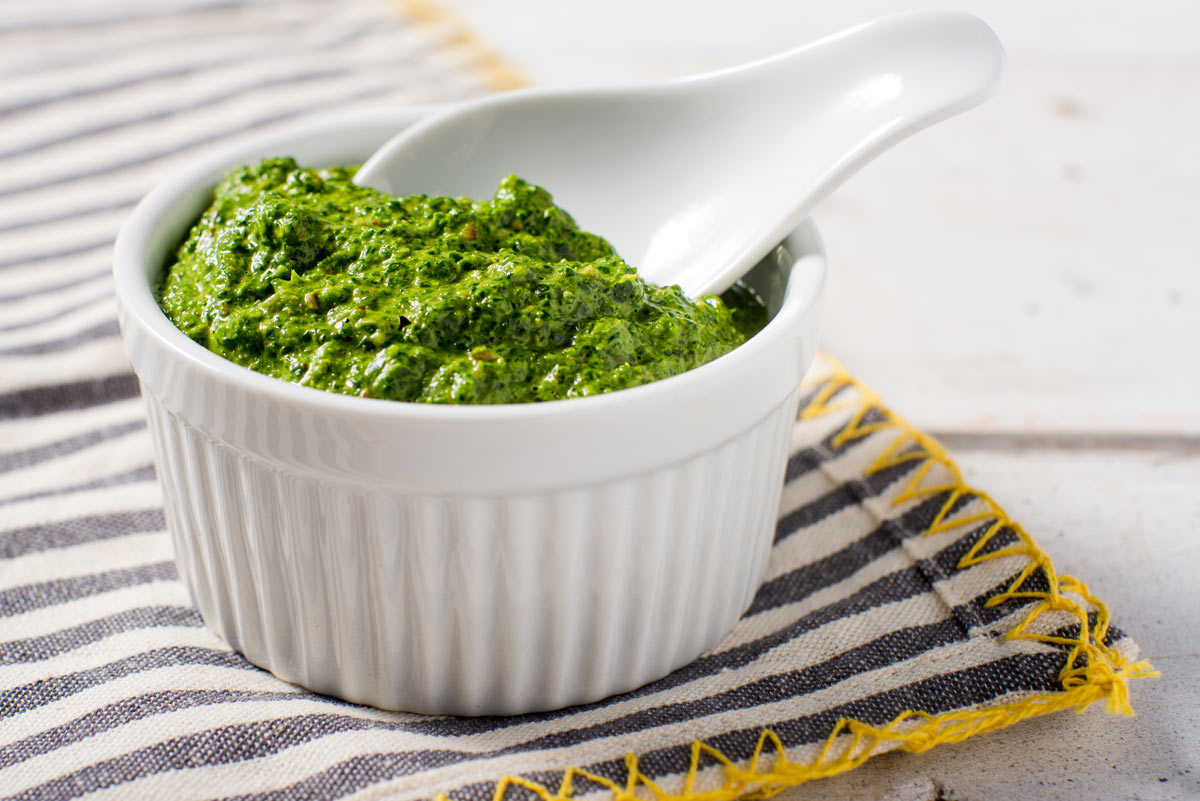Roast Chicken with Pumpkin Seed Pesto Recipe and Extra Virgin Olive Oil (EVOO) and Cancer Prevention
We know from a wealth of studies that the Mediterranean diet can help prevent various types of cancer, notably colon cancer, thanks to the abundant fiber in many of its foods. Equally exciting research now highlights the benefits of olive oil in particular in helping with cancer prevention, and it’s thanks to a very specific nutrient, oleocanthal.

Extra Virgin Olive Oil (EVOO) and Cancer Prevention
The Research: “Olive oil intake and cancer risk: A systematic review and meta-analysis,” PLoS One (2021).
“(-)-Oleocanthal and (-)-oleocanthal-rich olive oils induce lysosomal membrane permeabilization in cancer cells,” PLoS One (2019).
“(-)-Oleocanthal rapidly and selectively induces cancer cell death via lysosomal membrane permeabilization,” Molecular and Cellular Oncology (2015).
For the PLoS One review, done at the University of Athens in Greece, scientists analyzed 45 studies and found that the “highest olive oil consumption was associated with 31 percent lower likelihood of any cancer, breast, gastrointestinal, upper aerodigestive, and urinary tract cancer. Significant overall effects spanned both Mediterranean and non-Mediterranean participants.” They concluded:
“Olive oil consumption seems to exert beneficial actions in terms of cancer prevention.”
Studies done at Hunter College in collaboration with scientists from other New York area institutions help explain what might give extra virgin olive oil or EVOO, known for its anti-inflammatory properties, this cancer-fighting ability. For the Molecular and Cellular Oncology study, Hunter professor David A. Foster, PhD, and his coauthors, identified the role of oleocanthal (OC), a phenolic compound in EVOO, already credited for the health benefits linked to diets rich in EVOO. The team “investigated the effect of OC on human cancer cell lines in culture and found that OC induced cell death in all cancer cells examined as rapidly as 30 minutes.”
It turns out that oleocanthal damages cancer cells’ lysosomes, cell components that contain enzymes used to break down larger molecules like proteins. As explained in a news report from Hunter College, “The oleocanthal degrades the integrity of the lysosomal membrane, releasing the enzymes into the cells’ cytoplasm, which leads to cell death. Cancer cells often have larger and more numerous lysosomes, making them more vulnerable to oleocanthal than other cells.”
According to the scientists, different olive oils have different oleocanthal concentrations due to their origin, harvest time, and processing methods. For the 2019 PLoS One study, the researchers, including scientists from Weill Cornell Medicine, Rutgers University, and Albert Einstein College of Medicine, along with Hunter, tested a variety of olive oils to determine their respective concentrations of oleocanthal, ranging from very low to very high. The olive oils with high oleocanthal content completely killed cancer cells in a manner similar to purified oleocanthal. The olive oils with average oleocanthal content reduced their viability, but to a lesser extent. Those with no oleocanthal had no effect.
The researchers also tested oleocanthal’s effects by injecting it into mice engineered to develop pancreatic tumors. The oleocanthal injections extended the lives of the mice by an average of four weeks. If it were to have the same effect in humans, which is as yet unknown, that could translate to over 10 years.
“Whether oleocanthal can be used as a magic bullet to target cancer cells is not clear,” says Dr. Foster. “However, the data provided in this article validate studies indicating that extra virgin olive oils can prevent cancer.”
“Today, there are no brands of olive oil sold at grocery stores in the United States that mention ‘oleocanthal’ or other polyphenols on their label, and this might change as producers of olive oil catch up with the scientific research, and consumers become more savvy,” says Limor Goren, PhD, research associate at Hunter College and lead author of the 2019 study. She adds that consumers can also do their own taste test for oleocanthal: “Taste a small amount of an extra virgin olive oil; if there is a signature stinging sensation felt at the back of the throat, that is an indication of oleocanthal. It should feel peppery.”
Roast Chicken with Pumpkin Seed Pesto
 Roast Chicken with Pumpkin Seed Pesto
Roast Chicken with Pumpkin Seed PestoThis South American-inspired olive oil-rich pesto elevates simple roasted chicken and packs an herby punch.
Ingredients
- 1 3-1/2- to 4-pound chicken
- 2 tablespoons, separated, plus 1/3 cup extra virgin olive oil
- Kosher salt and freshly ground black pepper
- 1/2 cup hulled green pumpkin seeds (pepitas), unsalted
- 1/2 cup packed fresh cilantro leaves, rinsed and patted dry
- 1/2 cup packed fresh flat-leaf parsley leaves, rinsed and patted dry
- 2 large garlic cloves, peeled and coarsely chopped
- 2 tablespoons water, more as needed
- 1 tablespoon fresh lime, more to taste
- 1 teaspoon ground cumin
Directions
Step 1
Preheat your oven to 400°F. Place the chicken on a rack in a shallow roasting pan or rimmed baking sheet. Rub the chicken with 1 tablespoon of olive oil. Season the inside and outside generously with salt and pepper. Roast for 60 to 70 minutes or until the internal temperature in the thickest part of a thigh is 165°F. Let rest for 10 minutes before carving.
Step 2
While the chicken is roasting, prepare the pesto. Add 1 tablespoon of olive oil to a medium-hot skillet, and add the pumpkin seeds. Sauté until the seeds begin to pop, about 2 minutes, but don’t let them burn. Cool, and then transfer the seeds to the bowl of a food processor. Add the cilantro, parsley, garlic, water, lime juice, and cumin, and pulse several times. With the machine running, slowly add 1/3 cup olive oil until you get a purée. Season to taste with salt and pepper, and add more lime juice if needed. (If it’s too thick, add additional water, one tablespoon at a time.) Serve with the chicken. Refrigerate any leftover pesto to use as a dip.
Yields 2-3 servings
